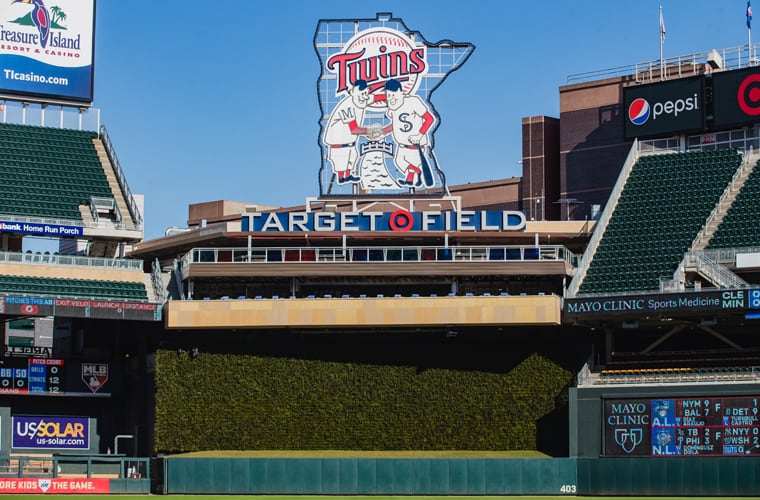
Target Field Nabs Another Environmental Honor, Supporting its Title as “The Greenest Ballpark in America”
Target Field’s new “living wall.” (Photo by: Ben Ludeman/Minnesota Twins)
For the second time, Target Field achieves the highest level of LEED (Leadership in Energy and Environmental Design) recognition.
Earth Day may not be an official holiday, but it’s certainly a day to celebrate for the Minnesota Twins. The team just announced their home stadium Target Field achieved the highest designation for environmentally-conscientious operations—Leadership in Energy and Environmental Design (LEED) Gold—for the second time.
LEED is a worldwide program for assessing how the design, construction and operation of high-performance buildings incorporates environmentally-friendly systems and practices.
Target Field first became LEED certified after the recent renovation was completed in 2010—earning Silver certification in the category of “new construction.”
Then, in 2011, the Twins became the first professional sports franchise to receive LEED Silver designation for two particular other categories: “construction” and “existing buildings: operations, and maintenance.”
The Twins advanced even further in recognition in 2017, becoming the first franchise to attain LEED Gold certification for operation and maintenance of Target Field.
But the Twins didn’t stop there.
“The Twins organization [is] fully committed to being an industry leader in regards to environmental sustainability,” says Twins president and CEO Dave St. Peter. “Growing Target Field’s sustainability platform remains a critical priority for the franchise and our fans.”
With this latest LEED Gold designation, Target Field became the nation’s first sports facility to earn the three levels of LEED certification through Arc, a new digital platform that determines certification level based on real-time data. Arc benchmarks, measures, and improves sustainability performance, tracking progress through a performance score. This encourages Arc users to make more informed decision when designing sustainability projects.
Expected to score the Twins and Target Field points with Arc in the future is a new addition to the team’s home field: a living wall, a vertical garden that is fastened to a structural support into which roots are then planted.
The Twins’ living wall, installed this year in the batter’s eye section of the field (a point beyond center field that serves as the backdrop for the batter’s line-of-sight), is the first of its kind for Major League Baseball venues. At 2,280-square feet, it’s also one of the largest such walls in the continental U.S., according to the Twins organization. The wall features more than 5,700 sea green juniper plants.
“Target Field is a prime example of how innovative technology and sustainable solutions can create a better experience for everyone who steps foot in this stadium,” says Mahesh Ramanujam, president and CEO of the U.S. Green Building Council (USGBC), which assigns LEED certifications. “The Twins organization’s commitment to LEED demonstrates a tremendous amount of green building leadership within the world of professional sports.”
The recent LEED Gold recertification supports the designation the USGBC gave Target in 2017 of “The Greenest Ballpark in America.”
The team’s other, previously implemented efforts toward environmental stewardship have involved: utilizing a Rain Water Recycle System—custom-designed by Minneapolis-based water treatment company Pentair —that has enabled the reuse of more than 19 million total gallons of rainwater at Target Field to date; an initiative with Delaware North Sportservice to donate more than 10 tons of food to local charities each season; the installation of LED light fixtures; and a partnership with Eco-Products to use compostable cups, plates, trays, utensils and straws throughout the ballpark.

